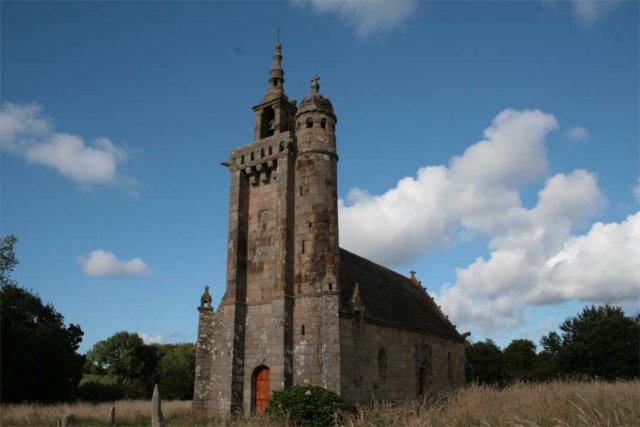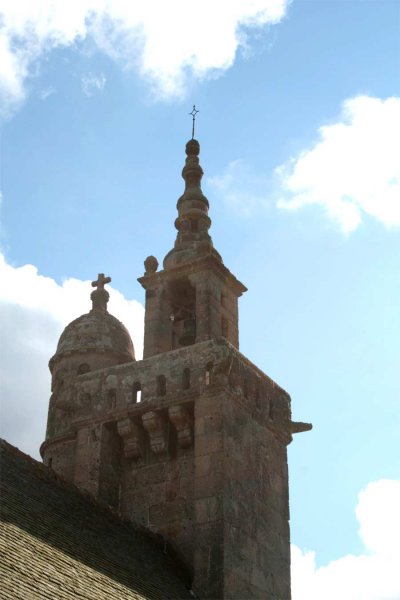The Saint-Samson Chapel
 The chapel of Saint Samson was built in two stages, between 1575 - 1631.
The chapel of Saint Samson was built in two stages, between 1575 - 1631.
It is the main element of a complex, combining the manor house (to the south) with which it used to be, the fountain (to the northwest), the entrance gate (to the north east), the Christianized menhir (moved to the foot from the porch).
A first phase, completed in 1575 (date formerly visible on a buttress of the gable), concerns the chapel itself (without the tower), small edifice of flamboyant Gothic style with a superb decorated door to the south (then only access door inside the building) and a bedside intended to receive, later, a painted stained glass window. This foundation would be at the initiative of the lord with the stronghold of Barac’h-Keruzec, who would have endowed this isolated territory with a Christian building, punctuating the life of the peasants.
A second phase, completed in 1610 (date visible on a fenestration), concerns the construction of a western massif, with entrance porch and bell tower composed of a square tower flanked by a turret staircase screw, surmounted of a dome. This achievement is inspired by the Beaumanoir style, developed during the previous century in the Lower Trégor, from Morlaix to Lannion, highly appreciated for its elegance and characterized in particular by a slender tower-wall.
The time of Louis XIII is a period of intense religious and cultural activity: chapels, ossuaries, crucifixes, altarpieces ... It’s the time of the Catholic Reformation, a great religious renovation enterprise that the Papacy had launched at the Council of Trent.
In Saint-Samson, the architectural program benefits from significant financial means since it quickly enriches the chapel of decorations, statues. In 1631, the inner sandpit was built. And, probably at the same time, we realized the paving which design and decoration intrigue the visitor: the reasons for rosettes and geometric shapes, the calculated layout of the paving stones, are not due to chance : but their real meaning remains a mystery.
A fountain was built in 1632; an inseparable element of the Breton chapels, the "votive" fountain, often called "healer", testifies above all to the power attributed to the forces of nature, which the Church intends to appropriate. The quality of the freestone construction bears witness to its importance within the architectural program of the ensemble.
The access from the north, near the fountain, is marked by two low walls, one of which presents a passage barred by a coping: the presence of this symbolic obstacle must alert the pilgrim to the presence of messages, which will be delivered to him. and that he will have to understand through the organization of the sacred space, the path that will be proposed to him, the elements of architecture and decoration that will allow him to admire. These walls, degraded and scattered in the twentieth century, have been recently restored.
In the 17th century, faced with a dilettante religious practice (the population, and sometimes the clergy themselves, is too often guilty of ignorance, even drunkenness or paganism), the Church intensified the activity of priest-fighters, such as Michel Le Nobletz or the father Julien Maunoir. We then witness the splendor of parish art, associating rectors, lords, but also parishioners; in the practices, one observes a permeability between the religious and the profane.
It is probably at this time that the christianized menhir (or peulven) is moved to be implanted at the foot of the new porch, in the axis of the building. According to legend, this erected stone was deemed to promote the fertility of newlyweds who had to come and rub themselves, naked, at night ... We tried to erase the phallic aspect by cutting the top in the shape of a cross, and placing the object in the sacred enclosure of the chapel. A few steps away, they "christianised" the menhir of "Penvern" (also called "Saint-Uzec") in a much more consistent way, probably under the influence of the preaching of Father Manoir, came in 1674 to Pleumeur-Bodou to encourage the religious fervor around the theme of sacrifice and the Passion of Christ.
The chapel of Saint-Samson in a few dates:
![]() 1575: foundation of the chapel
1575: foundation of the chapel
![]() 1610: west extension
1610: west extension
![]() 1629: sundial
1629: sundial
![]() 1631: inner runners
1631: inner runners
![]() 1632: fountain
1632: fountain
For twenty years, the municipality of Pleumeur-Bodou undertakes for the maintenance and renovation of this ensemble, with many works, large and small, including:
![]() 2001: doors, lighting and statues;
2001: doors, lighting and statues;
![]() 2007: stained glass window illustrating the Life of Saint-Samson.
2007: stained glass window illustrating the Life of Saint-Samson.
![]() 2011: facsimile of the sundial.
2011: facsimile of the sundial.
![]() 2014: access to the site.
2014: access to the site.
The chapel of Saint-Samson is considered as one of the most beautiful chapels of the Trégor, and one of the finest examples of parish art in Britain.
In July and August : open for the free visit from 2pm to 6pm except on sundays and public holidays.







